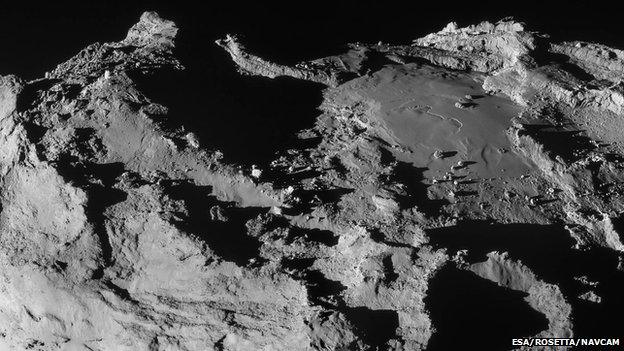Rosetta's comet throws out big jet
- Published

The 900m jet is seen to emerge from 67P's "underside" in the images taken two minutes apart
Europe's Rosetta probe has caught its comet quarry in the act of producing a huge jet of gas and dust.
The 4km-wide icy dirt-ball known as 67P is now throwing off copious amounts of material as it warms up on its journey in towards the Sun.
Rosetta is keeping a safe distance, but continuing to image the evolving body.
And in a series of new pictures from its Osiris science camera system, the probe watched the jet burst from the duck-shaped comet's "backside".
This is the region dubbed Imhotep, after the Ancient Egyptian god of wisdom and medicine.
The event was described last week at the European Geosciences Union General Assembly in Vienna, Austria.
Osiris team-member Carsten Güttler told the meeting: “We had a very lucky shot on 12 March. We took images just two minutes apart.
“In the first image, at the bottom of the nucleus, you see nothing. In the second image, within two minutes and 10 seconds, a complete jet has formed.
“The length of this jet is about 900m and with a two minutes’ travel time you can estimate a velocity, which is about 8m/s. That’s a reasonable number.
The Max Planck Institute for Solar System Research (MPS) scientist continued: “Also, this jet looks like it’s on the night-side of the nucleus, which is very intriguing, and the easiest explanation is that there is a little cliff standing out, which is just being illuminated by the Sun but is not seen by the spacecraft.
“If that’s the case, then we just have to have normal warming activity. If that’s not the case, we have to find another mechanism.”
It is the sunlit regions of the comet that should be most active, not the dark zones.
"This was a chance discovery", added Osiris Principal Investigator Holger Sierks, also at MPS in Göttingen, Germany.
"No-one has ever witnessed the wake-up of a dust jet before. It is impossible to plan such an image."

Comet jets: This series of images was acquired 31 January – 25 March
Jet production is only expected to increase in the coming weeks as Comet 67P moves towards perihelion – the closest it gets to our star in its looping journey through the Solar System.
This occurs on 13 August. On that day, the space duck will be inside the orbit of Mars and some 180 million km from the Sun.
Where Rosetta will be in relation to the comet at that stage is unclear.
The European Space Agency (Esa) probe has had to pull back in the past month to a separation of about 100km because ejected dust has been upsetting its navigation system.
Esa project scientist Matt Taylor recalls: “At the end of March, we were flying over what is roughly the neck region of the comet, and we started to have pointing problems because the star-trackers were getting confused in the dusty environment.
“And then we went into safe mode, and we flew away from the comet. That’s what Rosetta is designed to do – to stay out of danger.”

Imhotep: The jet must have emanated from somewhere in, or near, this region